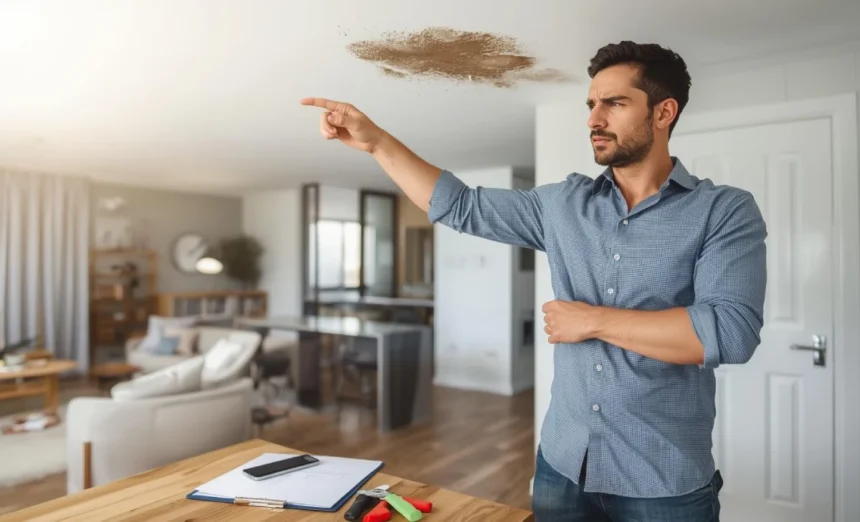Living in a rental property should mean enjoying a safe, well-maintained home. But what happens when your landlord ignores repair requests or outright refuses to fix essential issues?
- Understanding Landlord Obligations in Australia
- Steps to Take When a Landlord Refuses Repairs
- Involving the Tenancy Tribunal or Consumer Affairs
- Alternative Solutions Before Tribunal
- Preventing Repair Issues in Future Tenancies
- Conclusion
- FAQs
- Q1: What can I do if my landlord refuses to make repairs in Australia?
- Q2: What are considered urgent repairs in Australia?
- Q3: Can I arrange urgent repairs myself and deduct the cost from rent?
- Q4: How long does a landlord have to fix repairs in Australia?
- Q5: Can I stop paying rent if my landlord refuses repairs?
- Q6: Which authority can I contact about rental repair disputes?
For thousands of Australian tenants, landlord refusing repairs Australia is a real and frustrating problem. Whether it’s a leaking roof, faulty electrical wiring, or a broken hot water system, unresolved repairs can affect your safety, comfort, and legal rights. The good news is that Australian tenancy laws are firmly on your side, and you have clear pathways to enforce repairs when landlords fail to act.
This guide walks you through your rights, practical steps to take, and how to escalate matters legally if your landlord continues to delay or refuse necessary repairs.
Understanding Landlord Obligations in Australia
Australian tenancy legislation is clear: landlords must maintain rental properties in a reasonable state of repair throughout the tenancy. This obligation exists across all states and territories, though specific rules and processes vary.
Under residential tenancy laws, landlords are responsible for ensuring the property remains safe, secure, and fit for habitation. This includes structural repairs, plumbing, electrical systems, and essential appliances provided with the property. Landlords cannot simply ignore repair requests or pass the responsibility onto tenants unless the damage was caused by tenant negligence or misuse.
According to Fair Trading NSW, landlords must carry out repairs within a reasonable timeframe after being notified. What’s “reasonable” depends on whether the repair is urgent or non-urgent, and failure to comply can result in tribunal orders and financial penalties.
Urgent vs Non-Urgent Repairs
Australian tenancy laws distinguish between urgent and non-urgent repairs, with different timeframes and procedures for each.
Urgent repairs require immediate attention because they pose safety risks or make the property uninhabitable. Examples include:
- Burst water pipes or serious water leaks
- Blocked or broken toilets (when it’s the only toilet)
- Gas leaks or electrical faults
- Dangerous structural damage
- Failures in hot water, heating, or cooling systems (depending on weather)
- Broken security locks or doors
For urgent repairs, tenants can arrange repairs themselves (up to a specified limit) and seek reimbursement if the landlord doesn’t respond promptly. In NSW, this limit is $1,000; in Victoria, it’s $2,500.
Non-urgent repairs include issues that don’t immediately affect safety or habitability, such as minor plumbing leaks, damaged flooring, or worn carpet. These repairs still fall under landlord obligations but follow different notification and timeframe requirements.
State-Specific Rules
While landlord repair obligations exist nationwide, processes and timeframes differ across states. Here’s a comparison of key repair rules:
| State | Urgent Repair Limit | Urgent Timeframe | Non-Urgent Timeframe | Key Legislation |
|---|---|---|---|---|
| NSW | $1,000 | Immediate | Within a reasonable time | Residential Tenancies Act 2010 |
| Victoria | $2,500 | Immediate | 14 days (or as agreed) | Residential Tenancies Act 1997 |
| Queensland | $900 | Immediate | Within reasonable time | Residential Tenancies and Rooming Accommodation Act 2008 |
| Western Australia | $1,500 | Immediate | Within reasonable time | Residential Tenancies Act 1987 |
Understanding your state’s specific requirements is crucial when dealing with landlord refusing repairs Australia. Each state has its own tenancy authority and tribunal system for dispute resolution.
Steps to Take When a Landlord Refuses Repairs
If your landlord is refusing repairs Australia, following the proper process strengthens your legal position and increases the likelihood of a successful outcome.
Taking systematic, documented action is essential. Jumping straight to legal action without following proper notification procedures can weaken your case. Here’s what you need to do.
Communicate in Writing
Verbal repair requests aren’t enough. Written communication creates a legal record that proves you notified your landlord and when.
Send your repair request via email or registered mail to both your landlord and property manager (if applicable). Your written request should include:
- Your name, address, and contact details
- Clear description of the repair needed
- Date you first noticed the issue
- Whether it’s an urgent or non-urgent repair
- Request for confirmation and expected timeframe
- Photos or videos showing the damage
Keep copies of all correspondence. If you must communicate by phone first, follow up immediately in
Keep Evidence
Thorough documentation is your strongest tool when dealing with landlord refusing repairs Australia disputes.
Create a comprehensive evidence file that includes:
- Dated photographs and videos from multiple angles
- Written repair requests and landlord responses
- Records of phone conversations (date, time, who you spoke with)
- Quotes from licensed tradespeople
- Receipts if you arrange urgent repairs yourself
- Records of any inconvenience or costs caused by the delay
Use this simple tracking table to organise your evidence:
| Date | Issue Reported | Action Taken | Landlord Response | Evidence |
|---|---|---|---|---|
| 15/03/2025 | Hot water system not working | Email to agent | No response | Photos, email copy |
| 18/03/2025 | Follow-up call | Phone call logged | “Will get back to you” | Call notes |
| 22/03/2025 | Formal notice sent | Registered mail | Received 24/03 | Mail receipt |
This level of documentation becomes crucial if you need to escalate to a tribunal. Consumer Affairs Victoria reports that well-documented cases see significantly faster resolution times.
Follow Up and Send a Formal Notice
If your landlord doesn’t respond within a reasonable timeframe, send a formal notice of breach.
A breach notice (also called a notice to remedy) formally notifies your landlord they’re violating tenancy laws. Each state has specific forms and requirements:
- NSW: Use Form 1 (Notice of Breach – Failure to Repair)
- Victoria: Use a written breach notice referencing specific sections of the Residential Tenancies Act
- Queensland: Issue Form 11 (Notice to Remedy Breach)
Your breach notice must specify the repair needed, state it’s an obligation under tenancy law, and provide a reasonable deadline (typically 7–14 days for non-urgent repairs). After this deadline passes without action, you can escalate to the relevant tribunal.
Involving the Tenancy Tribunal or Consumer Affairs
When landlord refusing repairs Australia, situations can’t be resolved directly, state tribunals provide legal enforcement mechanisms.
Each Australian state has a civil and administrative tribunal that handles residential tenancy disputes. These tribunals have the power to issue binding orders forcing landlords to complete repairs, compensate tenants, or face penalties.
According to NCAT Annual Reports, repair disputes represent approximately 25% of all residential tenancy applications, with most cases resolved in the tenant’s favour when proper procedures were followed.
When to Lodge a Tribunal Application
Lodge a tribunal application when your landlord refuses repairs despite proper notification and reasonable timeframes have passed.
Appropriate situations for tribunal applications include:
- Urgent repairs ignored for more than 48 hours
- Non-urgent repairs unaddressed 14+ days after formal notice
- Landlord disputes their repair obligation
- Repairs completed poorly or not to standard
- Landlord threatens retaliation for requesting repairs
Before applying, ensure you’ve completed all required steps: written request, evidence collection, and formal breach notice. Most tribunals require proof you attempted to resolve the issue directly.
Application fees vary by state (NSW: $66; Victoria: $73.30) and are often reimbursed if you win. Processing times typically range from 4–8 weeks, though urgent applications can be expedited.
What to Expect During the Tribunal Process
The tribunal process is designed to be accessible without requiring legal representation.
After lodging your application, both parties receive a hearing date. The landlord must provide a written response explaining their position. During the hearing, you’ll present your evidence, and the member (similar to a magistrate) will ask questions and review documentation.
Typical tribunal outcomes include:
- Orders requiring repairs within a specific timeframe
- Compensation for tenant expenses or inconvenience
- Rent reduction until repairs are completed
- Permission for tenants to arrange repairs and deduct costs from rent
Tribunal orders are legally binding. Landlords who fail to comply face fines and potential prosecution. In Victoria, penalties can exceed $10,000 for repeated non-compliance.
VCAT data shows that approximately 70% of repair dispute applications result in orders favouring tenants, highlighting the strong legal protections available.
Alternative Solutions Before Tribunal
Several alternative approaches can resolve landlord refusing repairs Australia situations without formal legal proceedings.
Tribunal applications should be a last resort. Alternative solutions often achieve faster results with less stress and expense.
Mediation services: are available through state consumer affairs departments. A neutral mediator helps both parties negotiate a resolution. Fair Trading NSW reports that approximately 60% of mediated tenancy disputes reach an agreement without tribunal intervention.
Consumer Affairs assistance: is free in all states. Contact your local consumer affairs office, which can:
- Provide advice on your rights and next steps
- Contact your landlord on your behalf
- Issue formal warnings about non-compliance
Arranging urgent repairs yourself: is permitted under specific conditions. For genuinely urgent repairs, you can hire a licensed tradesperson and deduct reasonable costs (up to state limits) from your rent after following proper notification procedures. Keep all receipts and send them to your landlord immediately.
In a 2024 case study, a Sydney tenant successfully arranged emergency plumbing repairs after multiple ignored requests. After sending a registered letter with the plumber’s invoice, the landlord reimbursed the full $850 cost within days, avoiding tribunal proceedings.
Preventing Repair Issues in Future Tenancies
Proactive strategies can minimise the risk of encountering landlord refusing repairs Australia in your next rental.
Prevention starts before you sign a lease. When viewing properties, look beyond aesthetics to assess maintenance quality:
- Check appliances, plumbing, and electrical systems
- Note existing damage or maintenance issues
- Research the landlord or agency’s reputation through online reviews
- Ask current or former tenants about their maintenance experiences
Complete a detailed condition report during move-in. Photograph everything and note all defects, no matter how minor. This protects you from unfair bond deductions and establishes a baseline for future repair discussions.
Ensure your rental agreement includes clear maintenance clauses specifying:
- Landlord’s repair responsibilities
- Notification procedures
- Expected response timeframes
- Emergency contact details
Maintain a positive relationship with your landlord or agent through prompt communication and responsible tenancy. Landlords are often more responsive to tenants who report issues early and treat properties respectfully.
According to Tenants Victoria, tenants who conduct thorough pre-lease inspections and maintain detailed records throughout their tenancy experience 40% fewer repair disputes.
Conclusion
Dealing with a landlord refusing repairs Australia situation is frustrating, but you have powerful legal protections and clear pathways to resolution.
Remember the essential steps: communicate in writing, document everything thoroughly, send formal breach notices, and escalate to your state tribunal if necessary. Australian tenancy laws strongly support your right to a safe, well-maintained rental property.
Don’t accept substandard living conditions or landlord neglect. By understanding your rights, following proper procedures, and using available resources like consumer affairs and tribunal services, you can ensure repairs are completed promptly and legally.
Have you successfully navigated a repair dispute with your landlord? Share your experience in the comments below to help other Australian tenants facing similar challenges.
FAQs
Q1: What can I do if my landlord refuses to make repairs in Australia?
If your landlord refuses repairs, first put your request in writing, keep evidence (photos, videos, emails), and follow up formally. If they still don’t act, you can escalate to your state’s tenancy tribunal such as NCAT (NSW) or VCAT (Victoria).
Q2: What are considered urgent repairs in Australia?
Urgent repairs usually include issues that make the property unsafe or unlivable, such as gas leaks, burst water pipes, electrical faults, broken locks, or a dangerous roof leak. Each state’s tenancy laws define urgent repairs specifically.
Q3: Can I arrange urgent repairs myself and deduct the cost from rent?
Yes, in many states you can hire a licensed tradesperson to fix urgent repairs and deduct the cost from your rent, but only within legal cost limits and after notifying your landlord. Always keep receipts and proof.
Q4: How long does a landlord have to fix repairs in Australia?
Timeframes depend on whether repairs are urgent or non-urgent. Urgent repairs must be addressed immediately or within 24–48 hours, depending on state law. Non-urgent repairs usually have a longer timeframe, such as 14 days.
Q5: Can I stop paying rent if my landlord refuses repairs?
No. Tenants must continue paying rent even if repairs are delayed. Withholding rent could put you in breach of your lease. Instead, follow the correct legal steps or apply to your state tribunal for orders.
Q6: Which authority can I contact about rental repair disputes?
You can contact your state’s tenancy authority or tribunal, such as:
- NSW: Fair Trading & NCAT
VIC: Consumer Affairs Victoria & VCAT
QLD: RTA & QCAT
WA: Consumer Protection WA & SAT






